Featured Articles
THE BREAKDOWN: Andre Ward-Chad Dawson

 Sure, we could see a draw Saturday. But the writer thinks the man on the left, Ward, will be able to boast that he is the man at 168, because he has more ways to win than does Dawson. (Hogan Photos)
Sure, we could see a draw Saturday. But the writer thinks the man on the left, Ward, will be able to boast that he is the man at 168, because he has more ways to win than does Dawson. (Hogan Photos)
Andre Ward-Chad Dawson:
Oracle Arena, Oakland, California
Televised by HBO
12 rounds for Ward's WBA and WBC super-middleweight titles
Gaining recognition in boxing is different from other sports. For some, a polarizing personality, a back story, or in some cases, even a smile can be all that's needed to help pave the way to superstardom. Certain doors can be made to swing wide open, with the right people eagerly rubbing their hands together on the other side, waiting to make the most out of that unique polarizing quality a fighter may possess. Some fighters are fortunate enough that they don't have to rely exclusively on their skills in order to sell tickets.
For others, like the supremely talented Andre Ward 25-0 {13} and Chad Dawson 31-1 {17}, technicians who may have an argument for being the best in the world at what they do, the road to fame and fortune can be a more tedious one. Being the best does not automatically equate to popularity. Not in this, the topsy turvy world of boxing.
Now, imagine a world when news of the universally recognized best light-heavyweight in the world is stepping down in weight to challenge his super-middleweight equivalent is greeted with moans and groans from many of the boxing media, who feel they're being lead down the garden path just because the bout may not turn out to be much of a spectacle. Some have even bizarrely claimed that they won't even bother to watch the fight. Well pardon me, but since when did the sport of boxing become so dependent on the cosmetics as opposed to the competition? If I want to see an action filled bloody scrap, I needn't look any further than my local watering hole on a weekend, there's plenty of fisticuffs going on down there.
Some of my favourite fights throughout history have involved technicians –Whitaker-McGirt 1+2, McCallum-Kalambay 1+2, Marquez-Barrera etc. A technical chess-match doesn't necessarily translate into a stinker,
Seriously though, I'm sure you don't need to be reminded that we currently have two fighters who share the accolade of being the consensus choice as the best in the world, who have competed in the same weight class together for over four years now and are point blank refusing to face one another. I couldn't care less who's to blame anymore, the fact of the matter is both Floyd Mayweather and Manny Pacquiao are afraid to accept the toughest challenge that's out there waiting for them while Andre Ward and Chad Dawson are not.
While Andre Ward and Chad Dawson maybe competing for multi-divisional supremacy and recognition,they are also striving for –at least in my eyes– something of far bigger significance…greatness. Achieving it requires so much more than simply dominating inferior opposition between the ropes or by entertaining the masses outside them. Testing one's self inside the ring speaks far louder than any words. Should a fighter be successful in his quest for greatness, he won't have to utter a single word declaring it, the names etched on his resume will do that for him. This is the reason why I LOVE this fight. The two best fighters in their respective divisions, who are in their physical primes and who aren't afraid to step up and take a risk –a lost commodity in today's fight game– in order to find out who's the best. That's the way boxing should be.
Now that I've got my little rant out of the way, let's discuss the actual fight.
Firstly, Chad Dawson deserves enormous respect for agreeing to fight Andre Ward at his optimum weight of 168 pounds. Make no mistake about it, despite him suggesting otherwise, the decrease in weight for Dawson is not to be scoffed at or ignored. Dawson hasn't competed as anything other than a light-heavyweight in over six years while his opponent has been making weight and fighting within the 168 pound limit since turning pro back in 2004. As I'm sure most of you are aware, making weight is one thing, but being effective at it on fight night is another. Oscar De La Hoya paid the ultimate price for thinking otherwise when he was left empty after making the welterweight limit, a weight he hadn't met in over six years prior to being humiliated by Manny Pacquiao. I'd be very surprised if Dawson turns out to be nearly as drained as De La Hoya was but remember, against De La Hoya, Pacquiao utilized a speed-oriented strategy. There wasn't much physicality in Pacquiao's tactics that night. Ward, meanwhile, who imposes his own physical strength a lot more than Pacquiao does, to smother in close and grapple his opponents,may look to exploit any physical weakness he may sense in Dawson. Ward's strength at the weight is immense.
Because of Chad Dawson's superior height and reach, as well as his southpaw jab which is enhanced by his excellent hand speed, most are of the opinion that the shorter Ward must work his way inside and take the fight to Dawson in order to win, which of course, isn't beyond the realm of possibility. However, while I would certainly agree that Dawson's length could be problematic for Ward should the Oakland native choose to stand and box with Dawson, I don't believe this to be the case at all. You see, Dawson, who is slicker, probably a tad quicker and who puts combinations together better than Ward does, may be the better technician of the two, but I consider Ward to be the better tactician. Therein lies the difference. I believe Ward may employ a strategy that's a complete contrast to the maul and clinch spoiling act that most are anticipating, but more on that in a moment.
I consider Andre Ward, the owner of a quite brilliant inside/outside game, to be one of the most adaptable fighters around today. If I could describe Ward's philosophy on fighting in a short sentence, it would be by any means necessary. While this may be perceived as a somewhat negative comment, it's actually quite the opposite. If you look at some of the greatest fighters of all time, past or present, you'll see that the ones who achieved the most were the ones who weren't afraid to admit that sometimes an opponent presented enough danger to evoke a change in their tactics. Muhammad Ali knew he couldn't move away for fifteen rounds against George Foreman who could cut off the ring as well as anyone who's ever put on a pair, so he adapted. Roberto Duran knew he couldn't pressurize the far bigger Iran Barkley into submission the way he was accustomed to against his smaller lightweight prey, so he adapted. If you watch any of Andre Ward's last half dozen fights or so, you'll see a different tactical approach used in each of them. Ward, along with trainer Virgil Hunter, leave no stone unturned in searching for the appropriate battle plan. When it comes to analyzing and dissecting their opponent's strengths and weaknesses, the combination of Ward and Hunter may be unrivaled in the current boxing landscape.
While appearing on Showtime during the Super Six tournament, Andre Ward was compared to almost every African-American boxing Olympian, from Sugar Ray Leonard to Roy Jones Jr with Floyd Mayweather Jr thrown in between. From where I'm looking in,Ward is more reminiscent of Bernard Hopkins, sharing the same cerebral and analytical approach to boxing as the Executioner does. Ironically, they will soon have one more thing in common.
Back in April of this year, despite being 47 years-old, Bernard Hopkins managed to fight Chad Dawson pretty much on even terms. In all honesty, during the first half of the fight, I felt Hopkins did even better than that, managing to manipulate a far greater athletic talent, with faster hands and a similar skill set into fighting his fight. Even in defeat, Bernard Hopkins wasn't overwhelmed or beaten up and had done his homework as usual.
Back in 2009, Chad Dawson was unbeaten and considered one of boxing's best. Against a certain type of opponent, Dawson often looked spectacular. Fighters who attempted to stand and box with Chad, or who tried to take his head off, were often made to look foolish as a result of Dawson's superior athletic gifts and craft. Enter Jean Pascal. Despite the fight being in Pascal's hometown of Montreal, Dawson was considered a strong betting favourite. Pascal, the owner of fast hands with decent power, wasn't known for possessing much in the way of boxing acumen and ring intelligence, and therefore wasn't expected to provide much resistance against the consensus best light-heavyweight in the world. However, in what I consider to be one of the most impressive strategic displays of boxing seen in the last few years or so, Jean Pascal completely nullified Dawson's counterpunching ability by handing Dawson his only career loss to date. Jean Pascal got his tactics spot on. Because Dawson is a converted southpaw, whose power lies in his lead right hand, rather than his trailing left, Pascal was able to shut down Dawson's jab and surprise him by stepping in with fast, unpredictable combinations and power leads from the outside. He did this by first making Chad follow him around the ring. Then, by feinting Chad into his defensive position {Dawson uses the same defensive construct as Floyd Mayweather by rolling and bending at the waist within his shell} Pascal was able to step outside of Dawson's lead foot and hit him with right hands. Pascal was at a height and reach disadvantage against Dawson, yet managed to defy conventional wisdom by beating him to the punch from the outside.
Back to Hopkins.
Heading into their first and second encounter, many were of the opinion that Hopkins, as is currently the case with Ward, should be looking to turn the fight ugly by using every trick in the book to take Dawson, a known confidence fighter, out of his comfort zone. Instead, we saw Hopkins utilizing a similar strategy to what Pascal implemented by moving side-to-side, circling the perimeter of the ring, before falling in with right hand leads from the outside. By doing this, Hopkins managed two things. Firstly, he eliminated Dawson's best weapon, his jab. Secondly, Hopkins reduced Dawson, a natural counter-puncher, into being the stalker. Obviously Dawson went on to win the fight, but I thought he looked was made to look poor because of Hopkins' carefully thought-out tactics. When Dawson's doing the pursuing, he isn't nearly as effective as his punch output drops way off. I also believe Dawson struggles to put everything together when he's made to be the one who's pressing the action. After all, he is a natural counter-puncher.
It must also be said, that deterioration in a 47 year-old fighter played a major part in the eventual decision loss to Dawson. Maybe five or six years ago things would have been different for Hopkins, who may have been able to fight at the same pace for the full twelve rounds. Seeing how Hopkins nullified much of what Dawson set out to do while being past his best, leads me to believe that a younger Hopkins would have performed even better. Before I go any further, it must be said that while he looked subpar against both Jean Pascal and Bernard Hopkins, Dawson does deserve credit for almost turning the fight around against Pascal. Some believe Dawson was well on his way to forcing a stoppage heading into the final rounds before a cut over his eye caused the fight to be halted. And let's not forget, Dawson actually got the win over Hopkins. In the cold light of the day, any kind win over Bernard Hopkins is really a job well done.
Back to Ward.
Like Hopkins, I have no doubt that Andre Ward will have, at some point, taken note of the Pascal-Dawson fight. As a result, Ward will know that when Dawson is made to be the aggressor, his first reaction when an opponent transitions to offense is to bend at the waist, to his left and to defend, where he's available to hit with right hands. Don't get me wrong, I'm a Dawson advocate and like I mentioned earlier, if an opponent decides to stand and box with Dawson, forget about it. You'll soon see Dawson in full flow, throwing an array of punches in quick succession, doubling up on hooks and uppercuts on offense, combined with slick head and upper body movement on defense. If Ward is naive enough to neglect Dawson's pure boxing skills, then it could end up being a long night for him. However, if a fighter can lure Dawson into being the aggressor and give him very little with which to counter from, then you'll see a different, more passive Dawson, who goes from throwing every punch in the book to barely releasing his one-twos. This is the Chad Dawson that Andre Ward will hope to be confronted with once the fight gets underway. And with the correct choice in tactics, Ward may get his wish.
There aren't many fighters who are as proficient at identifying an opponent's best weapon and neutralizing it –another Bernard Hopkins speciality– as Ward is. From where I'm looking in, there's an obvious weapon that Dawson possesses which is also his best way of winning the fight, his jab. By keeping Ward in front of him and on the end of the jab for twelve rounds {I don't think we're going to see a knockout here} there's a distinct possibility that Dawson, with his slickness and fast hands, could secure a decision win. Having said that, should Ward manage to strip Dawson of his jab, which will be at the top of his agenda, then I'm not really sure how Dawson goes on to win the fight. Dawson isn't one dimensional by any means. Like Ward, he too has a very good inside/outside game, but I'm having a hard time imagining him controlling Ward with anything else other than with his jab.
Andre Ward, on the other hand, has multiple ways in which he can attempt to disrupt Dawson and win the fight:
#1. Ward can fight off the back foot and out of range of the Dawson jab, before feinting him into dipping low where he can nail him with right hands as his head is waist height. This is something Jean Pascal executed repeatedly against Dawson. Obviously, Ward and Pascal are different fighters. Pascal is a bigger puncher and is more explosive, but Ward is taller and has a longer reach. There isn't much between them when it comes to speed, but Ward has a far higher ring IQ and is definitely more instinctive than Pascal. Simply put, I think Ward is more than capable of replicating the Pascal strategy that gave Chad Dawson all sorts of problems.
#2. Should there be any hint of Dawson being weak at 168 pounds, Ward will likely weave his way inside behind a high guard, where he can then smother and spoil Dawson's best work. Dawson is a big physical guy and is very strong, but Ward's strength on the inside may prove too much even for Dawson, especially if he's had any problems making the 168 pound limit. limit. Ward is very tough to contain on the inside, as Carl Froch, Allan Green and even Sakio Bika soon found out. Neither of them could really prevent Ward from gaining the upper hand at this range. Also, Ward's left hook in close –possibly his signature punch– could be the deciding factor should the action unfold there. Southpaws are available for left hooks, just as they are for right hand leads. Again, Dawson is probably the slicker of the two fighters in close, but Ward is definitely the more physical. Ward's ability to throw short punches in close, while at the same time preventing his opponent from getting off any retaliatory shots, using his arms and elbows to block them, really is of the highest order. Ward is unquestionably one of the upper echelon fighters of any weight class when it comes to his in-fighting skills.
#3. Although I'd favour Dawson in a straight up boxing match in the middle of the ring, it's not inconceivable to think that Ward could meet and match him there. Ward's jab, not as lengthy or as refined as Dawson's, is superbly well timed. He's also extremely adept at throwing it to the body early in fights, which keeps his opponents having to adjust their guard slightly to compensate. I'd give the edge in punching power and throwing combinations to Dawson. Ward prefers to throw single,untelegraphed shots which are harder to time, but he's more than capable of stringing his punches together as well.
As good as I think Chad Dawson is, I just happen to think that Andre Ward is that bit better. Even if you take Ward's hometown advantage and Dawson's weight out of the equation, I'd still favour Ward over Dawson for no other reason than Ward has more ways of winning the fight that Dawson does. I think Ward will give Dawson the benefit of the doubt with regards to how strong he will be at 168 and start things off fighting at a distance, on the back foot, looking to entice Dawson into following him around the ring while eliminating Dawson's best weapon, his jab, in the process. Unlike some of Ward's previous opponents, Dawson can fight effectively in close, disguising his shots well behind his right shoulder inside his defensive posture. Ward's best in-fighting displays came against two fighters who have no inside game — Green and Froch– and are not in the same league as Dawson when it comes to defending or attacking in close and up on the ropes. Ward will take the fight to the inside only if he feels he'll have the strength advantage there. It's all about knowing what to do and when to do it for Ward.
As was stated here earlier, Ward isn't afraid to acknowledge his opponent's best attributes and adjust accordingly. There's no point in trying to stand and trade with a fighter like Marvin Hagler when there are other ways and means with which to fight him. Roberto Duran knew this, opting to counter by forcing Marvin into being the aggressor. As a result of the great Panamanian's work, Sugar Ray Leonard knew this also, going one better by handing Hagler his first defeat in more than ten years. Following the same line of thought, I think that Andre Ward will follow the pattern that was laid down by Bernard Hopkins, and Jean Pascal before him. Chad Dawson is a fighter who, when taken out of his comfort zone, be it stylistically or mentally, has a tendency to become bored and disinterested. Apparently John Scully's guidance is the remedy, but I'm not convinced. I think once Ward goes against the grain with his counter-punching opponent, the wheels will begin to slowly come off for Dawson.
Prediction:
Andre Ward's versatility should be the key to this fight. After a few close feeling out rounds, which will likely be split, Ward's capacity to assess and adjust to whatever the situation calls for could be the determining factor in the fight, whether it be to fight from a distance before stepping in with power leads to eliminate Dawson's jab and volume, or by taking the fight to close quarters should the weight-making process have affected Dawson in any way. No matter how I look at it, Ward is too well-rounded a fighter to allow himself to fight someone else's fight. Including Dawson's.
I consider Ward to be a younger, more athletic and vibrant version of Bernard Hopkins. Looking at how Hopkins, at 47 years-old, managed to take a closer to his physical prime Dawson out of his game, leads me to believe that Ward will be able to do the same. Unlike Hopkins though, Ward is in his physical prime right now; we may not have even seen the best of Andre Ward yet, who, I believe is going to get even better. As the fight wears on, I can see Dawson becoming demoralized by Ward's ability to have an answer for everything he attempts. It's a position Dawson, a believer in his own ability, has never really found himself in before. I think Dawson thrives on confidence whereas Ward, with his determination and drive, thrives on stripping it away from an opponent. Something's got to give…
I'm not short-changing Chad Dawson here.He clearly isn't what his pseudonym suggests, he's good, very good. But Ward is potentially great, very great, which is why I can't really envision anything other than a decision win for the aptly named “Son of God” who might just be the best fighter in the world at the moment.
Featured Articles
Avila Perspective, Chap. 323: Benn vs Eubank Family Feud and More
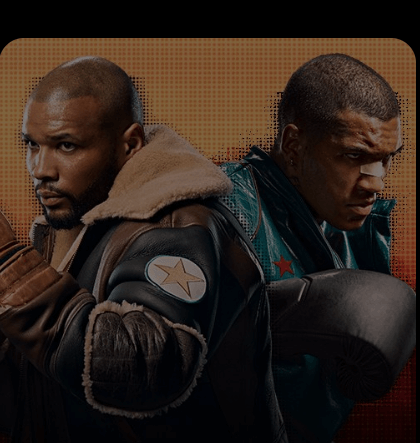
Next generation rivals Conor Benn and Chris Eubank Jr. carry on the family legacy of feudal warring in the prize ring on Saturday.
This is huge in British boxing.
Eubank (34-3, 25 KOs) holds the fringe IBO middleweight title but won’t be defending it against the smaller welterweight Benn (23-0, 14 KOs) on Saturday, April 26, at Tottenham Hotspur Stadium in London. DAZN will stream the Matchroom Boxing card.
This is about family pride.
The parents of Eubank and Benn actually began the feud in the 1990s.
Papa Nigel Benn fought Papa Chris Eubank twice. Losing as a middleweight in November 1990 at Birmingham, England, then fighting to a draw as a super middleweight in October 1993 in Manchester. Both were world title fights.
Eubank was undefeated and won the WBO middleweight world title in 1990 against Nigel Benn by knockout. He defended it three times before moving up and winning the vacant WBO super middleweight title in September 1991. He defended the super middleweight title 14 times before suffering his first pro defeat in March 1995 against Steve Collins.
Benn won the WBO middleweight title in April 1990 against Doug DeWitt and defended it once before losing to Eubank in November 1990. He moved up in weight and took the WBC super middleweight title from Mauro Galvano in Italy by technical knockout in October 1992. He defended the title nine times until losing in March 1996. His last fight was in November 1996, a loss to Steve Collins.
Animosity between the two families continues this weekend in the boxing ring.
Conor Benn, the son of Nigel, has fought mostly as a welterweight but lately has participated in the super welterweight division. He is several inches shorter in height than Eubank but has power and speed. Kind of a British version of Gervonta “Tank” Davis.
“It’s always personal, every opponent I fight is personal. People want to say it’s strictly business, but it’s never business. If someone is trying to put their hands on me, trying to render me unconscious, it’s never business,” said Benn.
This fight was scheduled twice before and cut short twice due to failed PED tests by Benn. The weight limit agreed upon is 160 pounds.
Eubank, a natural middleweight, has exchanged taunts with Benn for years. He recently avenged a loss to Liam Smith with a knockout victory in September 2023.
“This fight isn’t about size or weight. It’s about skill. It’s about dedication. It’s about expertise and all those areas in which I excel in,” said Eubank. “I have many, many more years of experience over Conor Benn, and that will be the deciding factor of the night.”
Because this fight was postponed twice, the animosity between the two feuding fighters has increased the attention of their fans. Both fighters are anxious to flatten each other.
“He’s another opponent in my way trying to crush my dreams. trying to take food off my plate and trying to render me unconscious. That’s how I look at him,” said Benn.
Eubank smiles.
“Whether it’s boxing, whether it’s a gun fight. Defense, offense, foot movement, speed, power. I am the superior boxer in each of those departments and so many more – which is why I’m so confident,” he said.
Supporting Bout
Former world champion Liam Smith (33-4-1, 20 KOs) tangles with Ireland’s Aaron McKenna (19-0, 10 KOs) in a middleweight fight set for 12 rounds on the Benn-Eubank undercard in London.
“Beefy” Smith has long been known as one of the fighting Smith brothers and recently lost to Eubank a year and a half ago. It was only the second time in 38 bouts he had been stopped. Saul “Canelo” Alvarez did it several years ago.
McKenna is a familiar name in Southern California. The Irish fighter fought numerous times on Golden Boy Promotion cards between 2017 and 2019 before returning to the United Kingdom and his assault on continuing the middleweight division. This is a big step for the tall Irish fighter.
It’s youth versus experience.
“I’ve been calling for big fights like this for the last two or three years, and it’s a fight I’m really excited for. I plan to make the most of it and make a statement win on Saturday night,” said McKenna, one of two fighting brothers.
Monster in L.A.
Japan’s super star Naoya “Monster” Inoue arrived in Los Angeles for last day workouts before his Las Vegas showdown against Ramon Cardenas on Sunday May 4, at T-Mobile Arena. ESPN will televise and stream the Top Rank card.
It’s been four years since the super bantamweight world champion performed in the US and during that time Naoya (29-0, 26 KOs) gathered world titles in different weight divisions. The Japanese slugger has also gained fame as perhaps the best fighter on the planet. Cardenas is 26-1 with 14 KOs.
Pomona Fights
Super featherweights Mathias Radcliffe (9-0-1) and Ezequiel Flores (6-4) lead a boxing card called “DMG Night of Champions” on Saturday April 26, at the historic Fox Theater in downtown Pomona, Calif.
Michaela Bracamontes (11-2-1) and Jesus Torres Beltran (8-4-1) will be fighting for a regional WBC super featherweight title. More than eight bouts are scheduled.
Doors open at 6 p.m. For ticket information go to: www.tix.com/dmgnightofchampions
Fights to Watch
Sat. DAZN 9 a.m. Conor Benn (23-0) vs Chris Eubank Jr. (34-3); Liam Smith (33-4-1) vs Aaron McKenna (19-0).
To comment on this story in the Fight Forum CLICK HERE
Featured Articles
Floyd Mayweather has Another Phenom and his name is Curmel Moton

Floyd Mayweather has Another Phenom and his name is Curmel Moton
In any endeavor, the defining feature of a phenom is his youth. Philadelphia Phillies outfielder Bryce Harper was a phenom. He was on the radar screen of baseball’s most powerful player agents when he was 14 years old.
Curmel Moton, who turns 19 in June, is a phenom. Of all the young boxing stars out there, wrote James Slater in July of last year, “Curmel Moton is the one to get most excited about.”
Moton was born in Salt Lake City, Utah. His father Curtis Moton, a barber by trade, was a big boxing fan and specifically a big fan of Floyd Mayweather Jr. When Curmel was six, Curtis packed up his wife (Curmel’s stepmom) and his son and moved to Las Vegas. Curtis wanted his son to get involved in boxing and there was no better place to develop one’s latent talents than in Las Vegas where many of the sport’s top practitioners came to train.
Many father-son relationships have been ruined, or at least frayed, by a father’s unrealistic expectations for his son, but when it came to boxing, the boy was a natural and he felt right at home in the gym.
The gym the Motons patronized was the Mayweather Boxing Club. Curtis took his son there in hopes of catching the eye of the proprietor. “Floyd would occasionally drop by the gym and I was there so often that he came to recognize me,” says Curmel. What he fails to add is that the trainers there had Floyd’s ear. “This kid is special,” they told him.
It costs a great deal of money for a kid to travel around the country competing in a slew of amateur boxing tournaments. Only a few have the luxury of a sponsor. For the vast majority, fund raisers such as car washes keep the wheels greased.
Floyd Mayweather stepped in with the financial backing needed for the Motons to canvas the country in tournaments. As an amateur, Curmel was — take your pick — 156-7 or 144-6 or 61-3 (the latter figure from boxrec). Regardless, at virtually every tournament at which he appeared, Curmel Moton was the cock of the walk.
Before the pandemic, Floyd Mayweather Jr had a stable of boxers he promoted under the banner of “The Money Team.” In talking about his boxers, Floyd was understated with one glaring exception – Gervonta “Tank” Davis, now one of boxing’s top earners.
When Floyd took to praising Curmel Moton with the same effusive language, folks stood up and took notice.
Curmel made his pro debut on Sept. 30, 2023, at the T-Mobile Arena in Las Vegas on the undercard of the super middleweight title fight between Canelo Alvarez and Jermell Charlo. After stopping his opponent in the opening round, he addressed a flock of reporters in the media room with Floyd standing at his side. “I felt ready,” he said, “I knew I had Floyd behind me. He believes in me. I had the utmost confidence going into the fight. And I went in there and did what I do.”
Floyd ventured the opinion that Curmel was already a better fighter than Leigh Wood, the reigning WBA world featherweight champion who would successfully defend his belt the following week.
Moton’s boxing style has been described as a blend of Floyd Mayweather and Tank Davis. “I grew up watching Floyd, so it’s natural I have some similarities to him,” says Curmel who sparred with Tank in late November of 2021 as Davis was preparing for his match with Isaac “Pitbull” Cruz. Curmell says he did okay. He was then 15 years old and still in school; he dropped out as soon as he reached the age of 16.
Curmel is now 7-0 with six KOs, four coming in the opening round. He pitched an 8-round shutout the only time he was taken the distance. It’s not yet official, but he returns to the ring on May 31 at Mandalay Bay in Las Vegas where Caleb Plant and Jermall Charlo are co-featured in matches conceived as tune-ups for a fall showdown. The fight card will reportedly be free for Amazon Prime Video subscribers.
Curmel’s presumptive opponent is Renny Viamonte, a 28-year-old Las Vegas-based Cuban with a 4-1-1 (2) record. It will be Curmel’s first professional fight with Kofi Jantuah the chief voice in his corner. A two-time world title challenger who began his career in his native Ghana, the 50-year-old Jantuah has worked almost exclusively with amateurs, a recent exception being Mikaela Mayer.
It would seem that the phenom needs a tougher opponent than Viamonte at this stage of his career. However, the match is intriguing in one regard. Viamonte is lanky. Listed at 5-foot-11, he will have a seven-inch height advantage.
Keeping his weight down has already been problematic for Moton. He tipped the scales at 128 ½ for his most recent fight. His May 31 bout, he says, will be contested at 135 and down the road it’s reasonable to think he will blossom into a welterweight. And with each bump up in weight, his short stature will theoretically be more of a handicap.
For fun, we asked Moton to name the top fighter on his pound-for-pound list. “[Oleksandr] Usyk is number one right now,” he said without hesitation,” great footwork, but guys like Canelo, Crawford, Inoue, and Bivol are right there.”
It’s notable that there isn’t a young gun on that list. Usyk is 38, a year older than Crawford; Inoue is the pup at age 32.
Moton anticipates that his name will appear on pound-for-pound lists within the next two or three years. True, history is replete with examples of phenoms who flamed out early, but we wouldn’t bet against it.
To comment on this story in the Fight Forum CLICK HERE
Featured Articles
Arne’s Almanac: The First Boxing Writers Assoc. of America Dinner Was Quite the Shindig
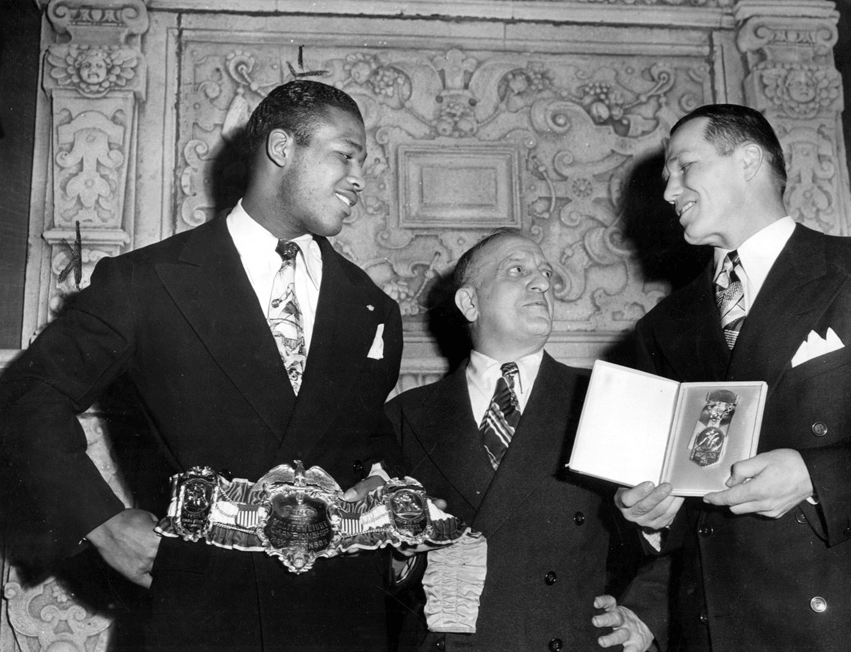
The first annual dinner of the Boxing Writers Association of America was staged on April 25, 1926 in the grand ballroom of New York’s Hotel Astor, an edifice that rivaled the original Waldorf Astoria as the swankiest hotel in the city. Back then, the organization was known as the Boxing Writers Association of Greater New York.
The ballroom was configured to hold 1200 for the banquet which was reportedly oversubscribed. Among those listed as agreeing to attend were the governors of six states (New York, New Jersey, Massachusetts, Pennsylvania, Connecticut, and Maryland) and the mayors of 10 of America’s largest cities.
In 1926, radio was in its infancy and the digital age was decades away (and inconceivable). So, every journalist who regularly covered boxing was a newspaper and/or magazine writer, editor, or cartoonist. And at this juncture in American history, there were plenty of outlets for someone who wanted to pursue a career as a sportswriter and had the requisite skills to get hired.
The following papers were represented at the inaugural boxing writers’ dinner:
New York Times
New York News
New York World
New York Sun
New York Journal
New York Post
New York Mirror
New York Telegram
New York Graphic
New York Herald Tribune
Brooklyn Eagle
Brooklyn Times
Brooklyn Standard Union
Brooklyn Citizen
Bronx Home News
This isn’t a complete list because a few of these papers, notably the New York World and the New York Journal, had strong afternoon editions that functioned as independent papers. Plus, scribes from both big national wire services (Associated Press and UPI) attended the banquet and there were undoubtedly a smattering of scribes from papers in New Jersey and Connecticut.
Back then, the event’s organizer Nat Fleischer, sports editor of the New York Telegram and the driving force behind The Ring magazine, had little choice but to limit the journalistic component of the gathering to writers in the New York metropolitan area. There wasn’t a ballroom big enough to accommodate a good-sized response if he had extended the welcome to every boxing writer in North America.
The keynote speaker at the inaugural dinner was New York’s charismatic Jazz Age mayor James J. “Jimmy” Walker, architect of the transformative Walker Law of 1920 which ushered in a new era of boxing in the Empire State with a template that would guide reformers in many other jurisdictions.
Prizefighting was then associated with hooligans. In his speech, Mayor Walker promised to rid the sport of their ilk. “Boxing, as you know, is closest to my heart,” said hizzoner. “So I tell you the police force is behind you against those who would besmirch or injure boxing. Rowdyism doesn’t belong in this town or in your game.” (In 1945, Walker would be the recipient of the Edward J. Neil Memorial Award given for meritorious service to the sport. The oldest of the BWAA awards, the previous recipients were all active or former boxers. The award, no longer issued under that title, was named for an Associated Press sportswriter and war correspondent who died from shrapnel wounds covering the Spanish Civil War.)
Another speaker was well-traveled sportswriter Wilbur Wood, then affiliated with the Brooklyn Citizen. He told the assembly that the aim of the organization was two-fold: to help defend the game against its detractors and to promote harmony among the various factions.
Of course, the 1926 dinner wouldn’t have been as well-attended without the entertainment. According to press dispatches, Broadway stars and performers from some of the city’s top nightclubs would be there to regale the attendees. Among the names bandied about were vaudeville superstars Sophie Tucker and Jimmy Durante, the latter of whom would appear with his trio, Durante, (Lou) Clayton, and (Eddie) Jackson.
There was a contraction of New York newspapers during the Great Depression. Although empirical evidence is lacking, the inaugural boxing writers dinner was likely the largest of its kind. Fifteen years later, in 1941, the event drew “more than 200” according to a news report. There was no mention of entertainment.
In 1950, for the first time, the annual dinner was opened to the public. For $25, a civilian could get a meal and mingle with some of his favorite fighters. Sugar Ray Robinson was the Edward J. Neil Award winner that year, honored for his ring exploits and for donating his purse from the Charlie Fusari fight to the Damon Runyon Cancer Fund.
There was no formal announcement when the Boxing Writers Association of Greater New York was re-christened the Boxing Writers Association of America, but by the late 1940s reporters were referencing the annual event as simply the boxing writers dinner. By then, it had become traditional to hold the annual affair in January, a practice discontinued after 1971.
The winnowing of New York’s newspaper herd plus competing banquets in other parts of the country forced Nat Fleischer’s baby to adapt. And more adaptations will be necessary in the immediate future as the future of the BWAA, as it currently exists, is threatened by new technologies. If the forthcoming BWAA dinner (April 30 at the Edison Ballroom in mid-Manhattan) were restricted to wordsmiths from the traditional print media, the gathering would be too small to cover the nut and the congregants would be drawn disproportionately from the geriatric class.
Some of those adaptations have already started. Last year, Las Vegas resident Sean Zittel, a recent UNLV graduate, had the distinction of becoming the first videographer welcomed into the BWAA. With more and more people getting their news from sound bites, rather than the written word, the videographer serves an important function.
The reporters who conducted interviews with pen and paper have gone the way of the dodo bird and that isn’t necessarily a bad thing. A taped interview for a “talkie” has more integrity than a story culled from a paper and pen interview because it is unfiltered. Many years ago, some reporters, after interviewing the great Joe Louis, put words in his mouth that made him seem like a dullard, words consistent with the Sambo stereotype. In other instances, the language of some athletes was reconstructed to the point where the reader would think the athlete had a second job as an English professor.
The content created by videographers is free from that bias. More of them will inevitably join the BWAA and similar organizations in the future.
Photo: Nat Fleischer is flanked by Sugar Ray Robinson and Tony Zale at the 1947 boxing writers dinner.
-

 Featured Articles4 weeks ago
Featured Articles4 weeks agoBoxing Odds and Ends: The Wacky and Sad World of Livingstone Bramble and More
-
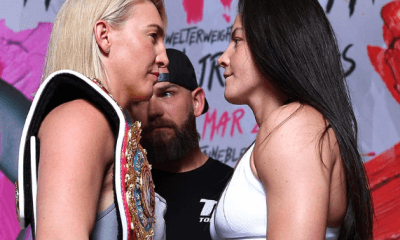
 Featured Articles4 weeks ago
Featured Articles4 weeks agoAvila Perspective, Chap. 319: Rematches in Las Vegas, Cancun and More
-

 Featured Articles4 weeks ago
Featured Articles4 weeks agoRingside at the Fontainebleau where Mikaela Mayer Won her Rematch with Sandy Ryan
-
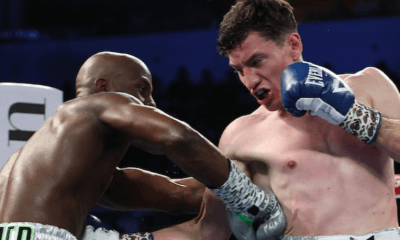
 Featured Articles4 weeks ago
Featured Articles4 weeks agoWilliam Zepeda Edges Past Tevin Farmer in Cancun; Improves to 34-0
-
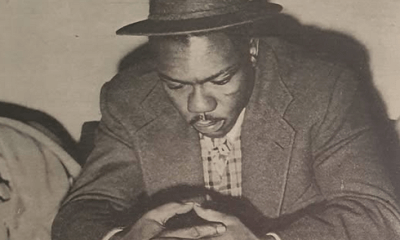
 Featured Articles3 weeks ago
Featured Articles3 weeks agoHistory has Shortchanged Freddie Dawson, One of the Best Boxers of his Era
-

 Featured Articles3 weeks ago
Featured Articles3 weeks agoAvila Perspective, Chap. 320: Women’s Boxing Hall of Fame, Heavyweights and More
-
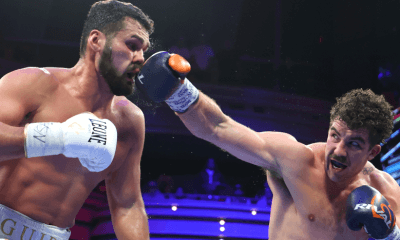
 Featured Articles3 weeks ago
Featured Articles3 weeks agoResults and Recaps from Las Vegas where Richard Torrez Jr Mauled Guido Vianello
-
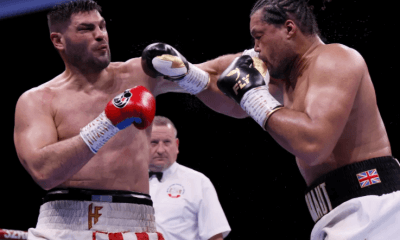
 Featured Articles3 weeks ago
Featured Articles3 weeks agoFilip Hrgovic Defeats Joe Joyce in Manchester















